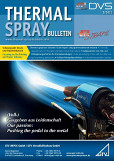Influences of process and material morphology on the case of carbide coatings
Authors: Alexander Barth, Dianying Chen, Chris Dambra
Wear and corrosion protection are the main applications for carbide cermet coatings which are most commonly applied by HVOF in the field of thermal spray technology [1, 2, 3]. The TriplexPro-200 offers to produce carbide coatings economically and at an outstanding quality level. The influence of spray parameters, material composition and morphology was investigated and put into comparison to the established HVOF process. Two spray parameters for the TriplexPro-200 were used: standard setup in which the particle velocities around 200 - 280 m/s and the high-velocity setup reaching particle velocities above 550 m/s. Materials with different morphologies were tested showing influences on coating structure and residual stress. The material compositions are WC-Co and WC-CoCr as they are widely used in wear and corrosion resistance. Coatings sprayed with the standard setup of the TriplexPro-200 show coating qualities beyond single cathode APS systems and at higher deposition efficiency and feed rate. In the high velocity operation window the coatings become HVOF like with hardness values up to 1200 HV 0.3 and very low porosity level.
The measurement of the residual stress shows that compressive stress can be achieved using the TriplexPro-200 technology.
Pages: 102 - 105




Order this article as a PDF for 8.00 Euro. Send us a short e-mail with your details.
An active subscription enables you to download articles or entire issues as PDF-files. If you already are a subscriber, please login. More information about the subscription








